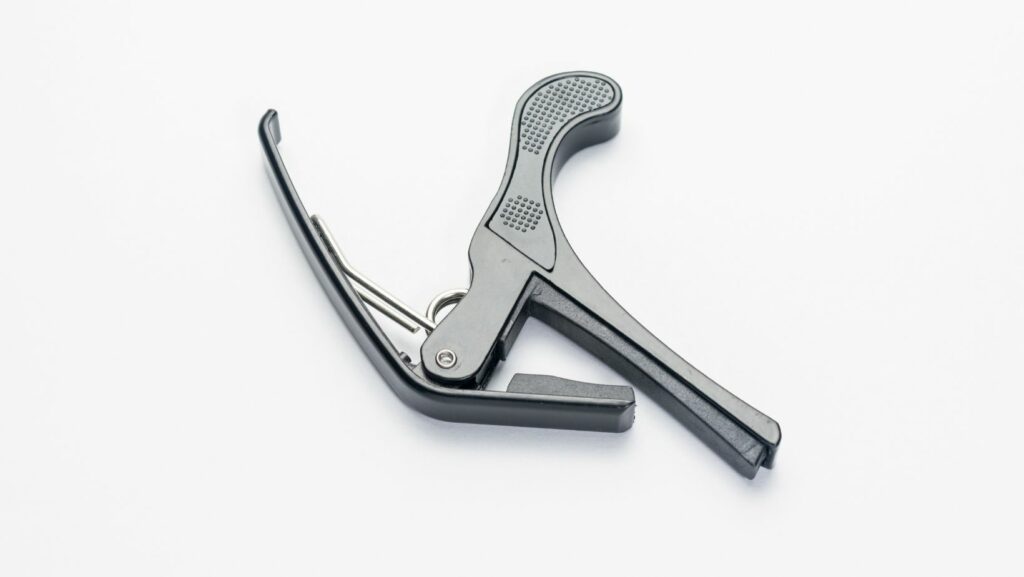There’s a certain charm in creating music with tools crafted by your own hands. It’s a unique feeling that can’t be replicated by any store-bought item. Today, we’re diving into the world of DIY capos – a small yet powerful tool that can transform your guitar playing experience.
DIY Capo

Capos deliver pivotal functionality in music creation. They provide the convenience of changing the key of a song without altering the chords. Guitarists benefit from a capo’s ability, for instance, when a song’s vocals are out of their vocal range. With a capo, it’s possible to pull the key down without drawback. It also allows for the implementation of distinctive open string sounds in a higher register, adding variety to a guitarist’s toolbox.
The role of a Capo extends to offering a practical solution for detuning. A Capo placed properly counteracts the uncomfortable tension generated by detuned strings. It opens up a realm of possibilities, expanding the creativity of a musician.
Making a DIY capo not only provides cost-saving benefits but also adds a personal touch. It develops a sense of attachment and pride in the musical craft. Capo’s importance in music is undeniable, and making one on your own elevates its significance further.
The DIY Capo Revolution

Indeed, the wave of do-it-yourself (DIY) capos stirs up a revolutionary impact on music creation. The musical world now encounters a resurgence in crafted capos, fostering a duality of functional practicality and personal creativity. Built DIY capos help musicians create distinctive sounds while also marking their journey. This impactful trend offers a cost-effective approach to music creation as it eliminates the purchase of commercial capos. By employing common household items such as pencils and rubber bands, musicians contribute their creative uniqueness to the musical horizon.
This journey of creating capos at home serves as a badge of honor, heightening musicians’ attachment to their craft. Instrumentalists can experiment and customize these DIY capos to their preferred specifications, enabling dynamic ways to change keys or create unique sounds. Thus, the DIY capo movement alters not just the physical landscape of music tools, but the emotional and existential aspects too. You can even find online tutorials that teach the detailed procedures of crafting a capo at home, fueling this revolution even further.
Building Your DIY Capo
 Entrenched in the cost-effective revolution of music creation, building a DIY capo improvises functionality with creative personal engagement. With simple household items at the core, the crafting process kicks off, typically involving a pencil and rubber bands.
Entrenched in the cost-effective revolution of music creation, building a DIY capo improvises functionality with creative personal engagement. With simple household items at the core, the crafting process kicks off, typically involving a pencil and rubber bands.
Next, rubber bands loop around the pencil and guitar neck, applying pressure on the strings. Musicians, who effectively execute this procedure, attain the key-shifting capabilities of a traditional capo.
Additional modifications, give rise to a range of tonal nuances, a unique feature of the DIY capo. The phenomenon, benefiting from a boom in online tutorials, continues to impact music creation on meaningful levels, extending beyond the fiscal characteristics.
Amid the DIY Capo Revolution, musicians wield the symbolic badge of honor. Not just an economic choice, these DIY capos come to symbolize musicians’ personal stake in their art, amplifying their craft’s emotional attachment.
Advantages and Disadvantages of DIY Capos
DIY Capos pose an enticing option, offering cost efficiency and a personal touch in music production. Crafted from readily available materials such as rubber bands and pencils, DIY capos provide tuning flexibility akin to commercial varieties. This customizability fosters a deeper connection between the musician and their instrument, nurturing personal investment in their craft. The DIY approach also promotes creative experimentation, enriching music creation potential.
However, DIY capos come with drawbacks. Constructing one calls for precision to ensure suitable pressure distribution on the strings. Inaccurate setup could lead to underperformance or even damage to the instrument. Depending on the materials used, DIY capos may lack durability, requiring frequent replacement. Artistic commitment, if coupled with access to online tutorials and patient practice, could help alleviate these challenges. Testing variations and getting comfortable with the DIY capo process enable musicians to reap the benefits while mitigating potential pitfalls.

